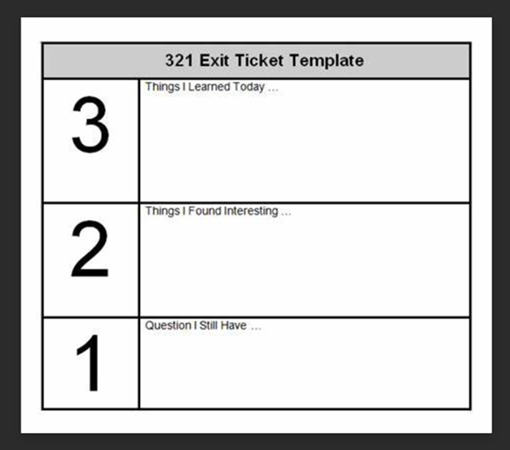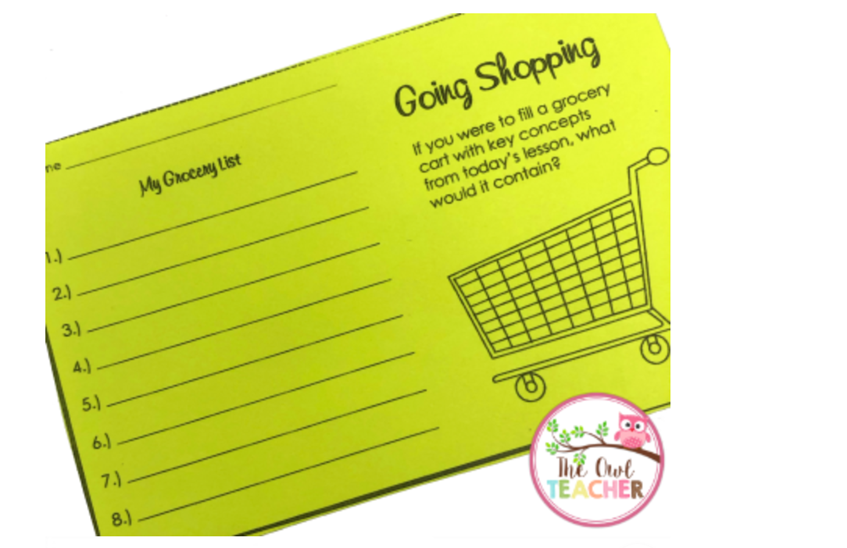Literacy Strategies 1 & 2: Annotations and Exit Slips
Student Choice
Annotating Texts Annotation can be used in both fiction and non-fiction texts, and in electronic documents or books. It is used to gain a deeper understanding of the text. An annotated text is a written text or electronic text that includes notes in the margins or between the lines. The notes are commentaries that are written by the reader as a way of interpreting or understanding the text. The notes can refer to the writer’s style or tone or to any literary or rhetorical devices that are used in the written text. In short, annotating text is used to analyze and interpret a text by putting the information into one’s own words. Annotating texts can be used in reader response criticism or just every day reading, where the reader is adding his or her own thoughts, feelings, definitions, and interpretations. The reader may have questions about the text or need to look up unfamiliar words, ideas, or phrases.
Exit Slips Exit slips are a type of formative assessment that are used to determine if a student has retained the information that was taught in the lesson. Exit slips can be used to help the teacher determine the students’ level of understanding and if there are subjects, ideas, concepts, or units that need to be retaught. Exit slips can be used to plan future instruction based on what students display that they know, do not know, or wish to know. Exit slips can provide teachers with an informal assessment of how well students have understood a topic or lesson. Exit slips also help students to reflect and do self-assessments on what they have learned (Reading Rockets, 2023). More importantly, exit slips can encourage students to think more critically by using open-ended questions (Indeed.com, 2023). There are many different types of exit slips. One of my favorite exit slips is the 3-2-1 exit slip. A 3-2-1 exit slip or assessment can be used to wrap up a lesson. This type of exit slip may include (3) things or three facts the students learned from the lesson. The number (2) indicates two things the students might have found interesting or two new words that were revealed through the text or context clues. The number (1) indicates one question the students may still have or one part of the lesson that might have been confusing. The students can write their 3-2-1 assessments on paper, or type them into a word processor or email, and then submit them electronically to the teacher.
ARTIFACT1: 3-2-1 Exit Ticket
Another fun and informative exit slip is a shopping cart. The idea of the shopping cart is for students to fill up the grocery cart with items or key concepts from the lesson they have just completed or been taught. The grocery cart would be a significant way to memorize and collect ideas and concepts, including vocabulary words. The list can be from eight to ten items or longer.
ARTIFACT 2 -Shopping Cart Exit Slip

The Owl Teacher. https://theowlteacher.com/24-exit-ticket-ideas/
Exit slips or tickets can also be a type of graphic organizer to help keep track of pertinent information for students and to obtain data on student progress for teachers. The benefit of annotating texts and using exit tickets is to provide methods of helping students to understand and determine how they learn best.
ARTIFACT 3: Annotated Bibliography An annotated bibliography will contain concise, specific, and pertinent information about the resource you are using, whether it is a book, a website, or a journal article. The annotated bibliography provides a brief synopsis or summary, such as an outline does. It creates a picture of the usefulness of a resource and the benefit of using or viewing that resource. In creating an annotated bibliography “keep in mind that all your text, including the write-up beneath the citation, must be indented so that the author's last name is the only text that is flush left” (Purdue University, 2023).
ARTIFACT 3 -Annotated Bibliography
References
Akcil, S. (2018). Cyberbullying-victimization, acculturative stress, and depression among international college students [Doctoral dissertation, Kent State University]. OhioLINK Electronic Theses and Dissertations Center. http://rave.ohiolink.edu/etdc/view?acc_num=kent1529712251699618
This study measures the effects of cyberbullying on young adults, and college age students in the United States and forty-two other countries. The purpose of the study was to measure the combined effects of cyberbullying/victimization, acculturative stress, and depression among international college students. The study has some limitations due to the unequal number of the participants from various countries and possible English language barriers. Many of the participants in the study were over the age of twenty-five, due to starting college late because of social and cultural issues. It has been proven by various studies that cyberbullying exists in middle, high, and college level American students. This study proves that cyberbullying also exists among international students and that cyberbullying victimization has a significant positive relationship with mental health problems such as acculturative stress and depression.
Atkinson, E. (n.d.). What is social networking bullying? https://bostinnovation.com/what-is-social-networking-bullying/#2
In the article, What Is Social Networking Bullying? The author, Elaine Atkinson, explores various aspects of cyberbullying. Atkinson gives examples of cyberbullying and discusses the social aspects of cyberbullying. Atkinson provides recent statistics on cyberbullying and highlights mental health aspects, and social and emotional consequences of cyberbullying. The author gives suggestions for methods to lessen or end cyberbullying. This article is useful in providing a picture or snapshot of cyberbullying and provides additional resources to become involved, educated, and to participate in the fight to combat and end cyberbullying. Atkinson also attaches an informative video at the end of her article, Social Networking: Cyber Bullying, which can be located on YouTube and along with the article on the Bost Innovation website.
Bark. (2017). The history of cyberbullying. The Bark Blog. https://www.bark.us/blog/the-history-of-cyberbullying/
The article, The History of Cyberbullying, on the Bark Blog is a useful resource to use to begin familiarizing oneself with the issue of cyberbullying. However, it is not an academic resource and should be backed up with research from academic and peer-reviewed journals or legitimate news sources. The blog is current and provides up-to-date information and resources with links to other sources of information, such as its Culture & Media, Digital Citizenship, and Digital Wellbeing links. Overall, the Bark Blog is a good place to start learning about current issues and topics, such as cyberbullying.
Greene, M. B. (2000). Bullying and harassment in schools. In R. S. Moser & C. E. Frantz (Eds.), Shocking violence: Youth perpetrators and victims—A multidisciplinary perspective (pp. 72–101). Charles C Thomas Publisher, Ltd.
This article summarizes the literature on bullying and harassment in schools, highlighting and interpreting those aspects of the literature that have a direct bearing on prevention and intervention strategies. The information is organized into four sections (1) the nature and extent of bullying and harassment; (2) individual, interpersonal, and familial characteristics of bullies and victims; (3) the influence of peers and adults; and (4) preventive and intervention strategies.
Greene, M.B. (2003). Counseling and climate change as treatment modalities for bullying in school. International Journal for the Advancement of Counselling 25, 293–302 (2003). https://doi.org/10.1023/B:ADCO.0000005528.59128.32
This article highlights that individual, group, and family counseling should be included in bullying prevention programs and strategies. The author observes that, if bullying is treated exclusively as a problem between bullies and victims or as a family problem, counseling efforts will have limited impact. The author believes that counseling strategies must be articulated within a systemic approach to bullying in schools, and the roles that students and adults play in actively or passively reinforcing bullying behavior must be addressed through school-wide and family efforts to change the norms and climate with respect to bullying. The pertinent literature is reviewed and steps to implement a systemic prevention strategy are outlined.
Juvonen, J., Graham, S., Shuster, M.A. (2003). Bullying among young adolescents: the strong, the weak, and the troubled. Paediatrics, 112 (6) (2003), pp. 1231-1237. https://www.publications.aap.org/pediatrics/article-abstract/112/6/1231/63549/Bullying-Among-Young-Adolescents-The-Strong-the?redirectedFrom=fulltext
The study highlights that bullying and being bullied have been recognized as health problems for children because of their association with adjustment problems, including poor mental health and more extreme violent behavior, and that it is important to understand how bullying and being bullied affect the well-being and adaptive functioning of youth. The authors used multiple data sources to better understand the psychological and social problems exhibited by bullies, victims, and bully-victims. The main outcomes of the study were assessed through peer reports of bullies and who were victimized by bullies. The study was conducted using self-reports of psychological distress, and peer and teacher reports of a range of adjustment problems.
Peled, Y. (2019). Cyberbullying and its influence on academic, social, and emotional development of undergraduate students. Heliyon, 5(3). https://doi.org/10.1016/j.heliyon.2019.e01393
This study investigated the influence of cyberbullying on the academic, social, and emotional development of undergraduate students. The study was conducted by interviewing and surveying 638 Israeli undergraduate students. Data was evaluated on the use of social media and the prevalence of cyberbullying on various electronic platforms. The study was conducted to understand the social, psychological, and physiological effects that cyberbullying has on the undergraduate student population, along with adjusting to college life, financial issues, personal life adjustment issues, and relocation issues.
Wikipedia. Suicide of Amanda Todd. (n.d.). Retrieved February 22, 2022, from https://simple.wikipedia.org/wiki/Suicide_of_Amanda_Todd
This Wikipedia page gives a snapshot and synopsis of the Amanda Todd story. It is a useful resource for finding basic information and beginning research. The information matches other news stories. However, Wikipedia can be edited by anyone, therefore, information taken from the site should be verified using other legitimate resources such as news articles, police reports, and/or academic and other media resources.
ARTIFACT 4: Annotated Fictional Story Excerpt from “An Occurrence at Owl Creek Bridge” by Ambroise Bierce
He was now in full possession of his physical senses. They were, indeed, preternaturally (The word preternatural means beyond what is normal or natural) keen and alert. Something in the awful disturbance of his organic system had so exalted and refined them that they made record of things never before perceived. (Organic system here refers to system or systems of the human body). He felt the ripples upon his face and heard their separate sounds as they struck. He looked at the forest on the bank of the stream, saw the individual trees, the leaves and the veining of each leaf--he saw the very insects upon them: the locusts, the brilliant-bodied flies, the gray spiders stretching their webs from twig to twig. (His senses were supernaturally heighted enough to see the small insects and perceive all their motions, and also to see the veins on the leaves). He noted the prismatic colors in all the dewdrops upon a million blades of grass. (It is like he is one with nature). The humming of the gnats that danced above the eddies of the stream, the beating of the dragon flies' wings, the strokes of the water spiders' legs, like oars which had lifted their boat--all these made audible music. A fish slid along beneath his eyes and he heard the rush of its body parting the water… (This section uses similes, metaphors and figurative language). Doubtless, despite his suffering, he had fallen asleep while walking, for now he sees another scene--perhaps he has merely recovered from a delirium. He stands at the gate of his own home. All is as he left it, and all bright and beautiful in the morning sunshine. He must have traveled the entire night. As he pushes open the gate and passes up the wide white walk, he sees a flutter of female garments; his wife, looking fresh and cool and sweet, steps down from the veranda to meet him. At the bottom of the steps she stands waiting, with a smile of ineffable joy, an attitude of matchless grace and dignity. Ah, how beautiful she is! He springs forwards with extended arms. As he is about to clasp her he feels a stunning blow upon the back of the neck; a blinding white light blazes all about him with a sound like the shock of a cannon--then all is darkness and silence (Owl Eyes, n.d.)! (What happens at this point? Has he been shot? Is he dreaming, or is he dead)?
This story is about a man who is hung at the Owl Creek Bridge. The author, Ambrose Bierce presents a fantastic and entertaining story with a twist at the end. He writes the story in such a way that anyone might be on the side of the protagonist, but the ending is somewhat unexpected and as surprising as the reason for the hanging itself.
References
Indeed.com. (2023). What is an exit slip? (With steps and examples). https://www.indeed.com/career-advice/career-development/exit-slip
Owl Eyes. (n.d.). An occurrence at Owl Creek Bridge. https://www.owleyes.org/text/occurrence-owl-creek-bridge/read/i#root-75217-7
Purdue University. (2023). Annotated bibliography samples. Purdue Online Writing Lab. https://owl.purdue.edu/owl/general_writing/common_writing_assignments/annotated_bibliographies/annotated_bibliography_samples.html Reading Rockets. (2023).
Exit Slips. WETA. https://www.readingrockets.org/classroom/classroom-strategies/exit-slips
Sample Templates. (n.d.). 3-2-1 exit slip. https://www.sampletemplates.com/business-templates/exit-ticket-template.html Tammy. (2023).
24 exit ticket ideas. The Owl Teacher. https://theowlteacher.com/24-exit-ticket-ideas/

